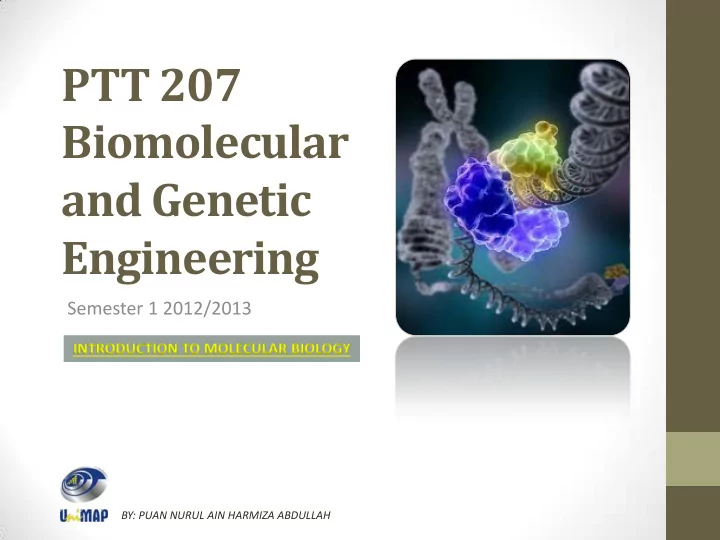

PTT 207 Biomolecular and Genetic Engineering Semester 1 2012/2013 BY: PUAN NURUL AIN HARMIZA ABDULLAH
Chapter 1 The Beginnings of Molecular Biology
1.1 Introduction
What is molecular biology? The study of biological phenomena at the molecular level, in particular the study of: • The molecular structure of DNA and the information it encodes; • The biochemical basis of gene expression and regulation.
1.2 Insights into the nature of the heredity material
Heredity • The transmission of characteristics from parent to offspring by means of genes.
Mendel’s laws of inheritance • The law of segregation. • The law of independent assortment. • The law of dominance. Q1: Find out about the experiments with peas and what are the 3 laws of inheritance by Mendel.
The law of segregation • During the formation of gametes, the paired hereditary determinants separate (segregate) in such a way that each gamete is equally likely to contain either member of the pair.
The law of independent assortment • Segregation of the members of any pair of hereditary determinants is independent of the segregation of other pairs in the formation of gametes.
The law of dominance • For each physical trait, one member of any pair of hereditary determinants is dominant so that the physical trait that it specifies appears in a 3:1 ratio . • The alternative form is recessive .
DNA is the hereditary material: each chromosome is a single molecule of DNA, and genes are sequences of DNA.
1.3 A model for the structure of DNA: the DNA double helix
• 1953: James Watson and Francis Crick proposed the double helix as a model for the structure of DNA. • Their discovery was based, in part, on X- ray diffraction analysis.
1.4 The central dogma of molecular biology
The Central Dogma was summarized by Francis Crick as follows: “Once information has passed into protein it cannot get out again”… Crick’s choice of the word “dogma” was not a call for blind faith in what was really a central hypothesis. According to Horace Judson in his book The Eighth Day of Creation , it was because Crick had it in his mind that “a dogma was an idea for which there was no reasonable evidence .” Crick told Judson “I just didn’t know what dogma meant … Dogma was just a catch phase.”
• Replication: The process of making an exact copy of DNA from the original DNA. • Transcription: The process of DNA being copied to generate a single-stranded RNA identical in sequence to one strand of the double-stranded DNA. • Translation: The process of the RNA nucleotide sequence being converted into the amino acid sequence of a protein. • Reverse transcription: the process of a single- stranded DNA copy being generated from a single- stranded RNA.
The central dogma of molecular biology. Dark gray arrows show transfer of information that occur in all cells; light gray arrows show transfer that can occur in special cases.
THANK YOU
Recommend
More recommend